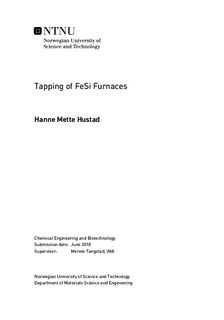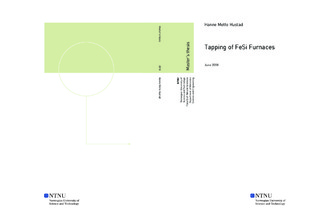| dc.description.abstract | Ferrosilicon is usually produced in an electric arc furnace. During the tapping of the furnace solidification of FeSi and slag in the runner and ladle are a major issue because it lowers the ferrosilicon yield and causes hazardous situations for operators who cleans the runner for solidified materials. This study investigates how temperature in the runner and ladle is affected by furnace operations, conditions during tapping, properties of FeSi, and slag and FeSi compositions. This is done by measuring temperatures in the runner and ladle during tapping of FeSi in a ferrosilicon production plant, chemical analysis of FeSi and slag samples, and heat transfer modelling.
There were two campaigns at ferrosilicon producer Finnfjord AS that had the goal of measure temperatures in the runner and ladle during tapping sessions, and collecting FeSi and slag samples in a 19 MW furnace that tapped discontinuously. The temperature of FeSi in the runner was measured continuously with C-type thermocouples during some tapping session. Two K-type thermocouples were also embedded inside the runner in the last campaign, one close to the furnace and another close to the end of the runner, that measured the temperature in the runner continuously for the duration of the campaign. The temperatures in the ladle were point measured with both C-type thermocouples and S-type thermocouples. Point measurements with S type thermocouples were done every 5 minutes when conditions allowed it. FeSi samples where also collected every 5 minutes during the first tapping sessions when conditions allowed it. The frequency of the FeSi sampling was decreased to 1-3 samples per tapping sessions after that. Observations during tapping sessions were also noted, and operational data was collected and normalized.
FeSi samples were crushed and milled to fine FeSi powder. The powder was pressed to pellets and analyzed for chemical composition with X-ray fluorescence (XRF). The slag samples were cut, molded in epoxy, and polished. The slag samples were than analyzed for chemical composition with electron-dispersive spectroscopy (EDS) in a scanning electron microscope (SEM).
The heat transfer model calculated the temperature difference caused by heat convection and thermal radiation in the runner, when FeSi is in free fall between runner and ladle, and in the ladle during simulated tapping sessions. Heat capacity of FeSi, emissivity of FeSi, diameter of FeSi flow, and mass flow rate was chosen to vary over several cases run on the model.
Measurements with S-type thermocouples in the ladle showed that FeSi temperatures varied between 1650-1465 C throughout tapping sessions. The measurements can be characterized into four groups based on trends, events during tapping, and furnace operations. The temperature in the runner was measure to be around 1760-1920 C, and it was found that variations may depend on movements of the electrode closest to the tapping hole.
The estimation of heat transfer coefficient, h_c, used in the modeling varied greatly from 7.8 W/(m^2K) to 38 373 W/(m^2K). The reason for this can be assumptions made during calculations that requires a low heat transfer coefficient. The heat transfer coefficient calculated based on own measurements was used for further calculations. The model showed that the emissivity of FeSi plays a large part for the total heat loss during the simulated tapping sessions, but previous works suggests that emissivity of FeSi can be as low as 0.2. Slag on top of liquid metal, however, can increase the emissivity. It is possible that heat capacity of FeSi does not vary as greatly with temperature in reality, and it is therefore possible that the change of heat capacity with temperature does not play a large role in the total heat loss during tapping. It was also found through modelling that the velocity of metal flow may play a larger part in the total heat loss during tapping than the diameter of FeSi flow when the mass flow rate is held constant. The mass flow rate was also found to play a major role in supplying heat to the ladle during tapping.
It was found that aluminum and calcium impurities in the FeSi samples varied very little during a tapping session. It was also found that they do not correlate with neither ladle nor runner temperatures, which contradicts previous works. There were some trends suggesting that low ladle temperatures gives low concentrations of aluminum and calcium and high temperatures gives high concentrations. It was found that aluminum and calcium concentrations in FeSi depends on both temperature and added carbon materials in excess of the normal recipe.
Four slag samples were also collected after some tapping sessions and it was found that high viscosity slag with high amounts of silicon was found just around the tapping hole and stuck to the equipment used by operators. Low viscosity slag was found further down the runner, and it seems that only this type of slag can find its way down to the ladle. However, further studies are needed to fully understand the interaction between slag and FeSi during tapping of ferrosilicon furnaces. | |

